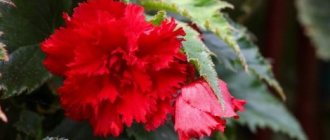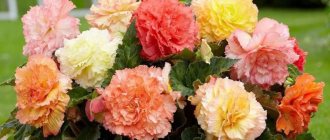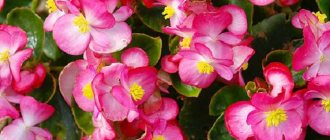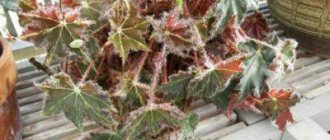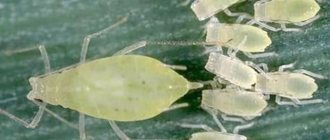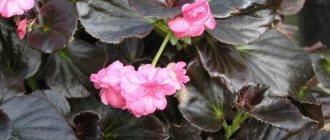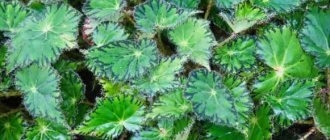Tuberous begonia is a beautiful decorative flower, suitable for both home and garden cultivation. It is quite capable of competing with such a universal favorite as a rose, because the flowers of tuberous begonia in their shape resemble a delicate pink bud. It may not be presented as a bouquet and then placed in a vase, but it is not inferior in the variety of shapes and shades. It can also delight its owner with almost constant flowering, and requires very little care and floriculture knowledge. So, if you are interested in a flower such as tuberous begonia, planting and caring for it at home will not be difficult for you. It is enough just to know some necessary subtleties.
Description and features of begonia
A large number of tuberous hybrids have now been developed. They have differences, but there are five features that are characteristic of this type of begonia:
- The root is an underground tuber (5-6 cm).
- The stem is thick, 25 cm high, 80 cm long.
- The leaves are dark or light green, glossy and fleecy. Heart-shaped. Arranged alternately and asymmetrically.
- The flowers are varied, from simple to double, red, white, yellow and other colors. Single-colored, bordered, small or large, solitary or in inflorescences.
- The fruit with seeds is a 1 cm box containing almost 1 thousand small seeds.
Tuberous begonias grow equally well in open ground, at home and on the balcony.
The tuber, which accumulates all the substances necessary for the life of the flower, helps it in any conditions.
Description of the plant
The indoor flower Begonia belongs to the genus of the same name in the Begoniaceae family. The genus has about 2000 species, some of them formed naturally, the other, most of them, thanks to breeders. In nature, most representatives grow in South America, Asia and Africa. In other countries, begonia is cultivated as a garden or indoor plant.
Begonia
Members of this genus may appear as a shrub, subshrub, herbaceous plant or vine. Its appearance may also differ, both in the color and shape of the flowers and leaves. Most are characterized by asymmetrical leaves with distinct veins, capsule-shaped fruit, monoecious flowers and rich petal color.
Indoor begonias rarely grow to 100-120 cm, more often they either stop on their own, or they are formed to a height of about 50 cm. Some varieties attract attention with beautiful flowers, others with decorative foliage.
The flowering period is also different: it all depends on the type and variety. The buds can be double or non-double, small or large, the plant can have different shapes of inflorescence and different colors of petals: there are white, pink, yellow, red and even orange begonias.
Often sellers hide the color of the petals under the word “mix”, indicating only the type of flower.
What to do next after the begonia has bloomed also depends on the type of flower. It is worth remembering that begonia is a perennial plant, and it begins to gradually prepare for rest.
Begonia flower
At the moment there is no single generally accepted classification. For convenience, flower growers conditionally divide them into several groups. The most complete is the European conventional classification based on biological characteristics, which includes eight groups:
- Cane begonias, with characteristic swellings or thickenings at the nodes of the stem. They are also called reed begonias.
Reed begonia, variety Begonia maculata - The bush type is similar to the previous group, but with less rigid stems, without thickening at the nodes.
Begonia collarata - Rhizomes or rhizomes are distinguished as a separate species due to their underground root-stem. The above-ground part of the plants consists of long petioles with leaves or inflorescences. This group of plants has a herbaceous or semi-shrub form.
Begonia Griffin - Royal or rex begonias are a variety of rhizomes. Most of the group consists of royal hybrids, and is characterized by brightly colored foliage.
Begonia rex - Thick-stemmed begonias are also a subspecies of rhizome begonias, mostly of the vertical type. Characterized by thicker, almost unbranched stems.
Begonia tamaya - Ever-blooming plants are so named for their constant flowering in suitable conditions. Another characteristic feature of this group is the round, shiny leaves.
Begonia everblooming - Tuberous plants are characterized by a water-storing tuber or caudex (a thickened stem that turns into roots). This group of begonias has very spectacular flowering.
Tuberous begonia - Climbing begonias have flexible stems. They crawl, hang or climb along the decorative base.
Climbing begonias
The first five groups belong to decorative deciduous species, the last three – to species with spectacular flowering. Sometimes the latter group is called flowering or beautiful-flowering begonias. The characteristics of each of these 8 groups have their own characteristics in home care, and in order to take care of a flower, you need to understand what type it belongs to.
Main varieties of begonia
There are many types and varieties of tuberous begonias.
They can be divided according to their features:
| Type | Description | Leaves | Bloom |
| Everblooming | Herbaceous perennial with a height of up to 36 cm depending on the variety. In the summer they are planted in the garden, in the winter they are placed at home. | Round green or burgundy. | White, yellow, pink, coral. Terry or simple. Most of the year. |
| Coral | Height - slightly less than 1 m. Unpretentious in home care. | Elongated, jagged. They are distinguished by matte finish and light speckles. | Red shades. Collected in inflorescences resembling corals. Early spring - first frosts. |
| Deciduous | Decorative indoor plant with drooping stems. Very capricious. Not grown outdoors. | Unusual colors: various contrasting patterns, spots, silver and pearlescent tints. | Small nondescript ones. Often absent. |
| Type | Varieties | Flowers |
| Erect | Dark Red | Large, dark red, like a rose. |
| Double yellow | Large yellow double ones. | |
| Party Dress | Reminiscent of the original huge carnations on a small bush. | |
| Camellia | Camel-shaped. | |
| Camellia Flora | Peony-shaped, waxy, pale pink with a snow-white border. | |
| Crispa White-red | They look like a large carnation, white with a burgundy or scarlet border. | |
| Picoti Lace Apricot | Terry, corrugated, apricot color, very large. | |
| Samba | Pastel colors of various shades, reminiscent of carnations. | |
| Ampelous | Chanson | Medium, semi-double or double, two-tone, camellia-like, in a variety of colors. |
| Christie | White terry. | |
| Sutherland | Small, simple sunny shades. | |
| Pikoti Cascade | Peony-shaped. |
Variety of subspecies
Tuberous begonia (Begonia tuberhybrida) is a species of the whole family Begoniaceae. Now feeling comfortable in the middle zone, this plant came to us from the tropics. The unpretentiousness of the plant, combined with abundant and long flowering, appealed to flower growers, as a result of which breeders developed many varieties of tuberous begonia. These are, for example, double varieties that have large and small flowers, while the leaves and flower petals have a whole variety of shapes and shades.
Caring for tuberous begonia at home
Begonia is an easy flower to care for, and you can certainly grow a beautiful flowering plant if you follow a few growing rules.
Planting a begonia tuber in a pot
When purchasing tubers, follow the following recommendations:
- The best time for this is the end of January - beginning of March.
- Size - at least 3 cm, color - rich brown, without stains or damage.
- The presence of buds, but not grown.
Planted at the very beginning of spring:
- The container for planting is of medium size.
- A drainage system made of expanded clay and small stones for 1/3 of the pot is required.
- The soil is peat. When the buds grow to 5 cm, they are transplanted into begonia soil or substrate: sand, leaf soil, peat soil and humus (1: 1: 1: 1).
- The rounded side of the tuber is immersed in the soil, and the concave side is placed upward without deepening so that the sprouts can breathe.
- When rooting, add soil and cut off excess shoots. If the planting material does not exceed 5 cm, no more than 2-3 are enough.
By purchasing an adult plant, it is adapted to home conditions.
For a week or two, the flower is placed in the shade, without watering or fertilizing. They look for the presence of insects.
Planting tuberous begonia at home
Buying a begonia tuber
As a rule, gardeners buy or receive a begonia specimen in the form of a tuber (or part of a tuber).
If you buy the tuber yourself, pay attention to how it looks. Its size must be at least 3 cm in diameter. The main thing is that the tubers are dense (not overdried) and smooth, without suspicious spots or damage.
The tuber has a top and a bottom, sometimes it is difficult to distinguish them. On the upper part there are tubercles and irregularities - these are buds, growth points. The top of the tuber is more concave or flat, and the bottom is convex. Very large tubers can even be divided into 2-4 parts with a knife. The main thing is that each one has at least 3 buds - growth points.
Planting tubers in containers
At the end of February, the dormant period of tuberous begonias ends. This is clearly visible from the swelling and germination of the buds of tubers of adult begonias and the awakening of small nodules that overwintered in the previous pots (so as not to dry out). The best time for planting begonia tubers for germination is March - early April (depending on the readiness of the tuber and the time of its acquisition). There are some tubers that wake up only in April.
First of all, you need to fill the shallow, wide planting containers with soil mixture. The main requirement for it is nutritional value and friability. Begonias thrive in a soil mixture made up of loose compost, peat and sand. It is advisable to add a little wood ash. We do not fill the pot to the very top. Approximately 1/2 - 2/3 of its height or 7 - 8 cm below the top edge of the pot. After this, we compact the soil and water it with a solution of complex fertilizers for flowering plants.
While the substrate is saturated with moisture, we have time to start preparing the tubers for planting. Begonia tubers are covered like a fur coat with the remains of old roots. The upper part can be recognized by dormant buds and traces of the previous year's stems. If the buds are almost invisible, then the tuber is left in a bright place to speed up the appearance of the eyes. There is another way to avoid turning the tuber over when planting upside down. Its convex part should be in the ground, and its concave part should be on top.
We inspect the tubers again (they should not have any questionable flaws), after which we clean them of old roots and soil remaining from last year. At the slightest suspicion, we disinfect the peeled tubers in a pink solution of potassium permanganate or use another sanitary treatment option.
Some amateur gardeners plant tubers, which are first soaked in clean, warm water. Sometimes growth stimulants are used. They believe that this more actively awakens the tuber and accelerates the appearance of shoots. Unfortunately, such water procedures can result in tissue rotting.
If there are a lot of tubers, then we select the best, the strongest, the youngest, with a diameter of 5 - 6 cm. We plant the rest “in reserve”. Healthy large tubers can be divided into parts and subsequently used as full-fledged planting material. The main thing is to keep at least one viable bud on them. To do this, they are first germinated in containers filled with a mixture of peat and sand. As soon as shoots begin to appear, the tubers are taken out and divided into several parts. The cuts are sprinkled with crushed activated carbon or treated with brilliant green. They are given the opportunity to dry by leaving them for a day in a dry room at room temperature.
It is worth mentioning about old tubers, the age of which is approaching the age limit (five to six years). They are larger (8 - 9 cm) and have many buds. During its life, the shape of the tuber changed, becoming deformed, not even, but angular. Outgrowths and traces of past shoots have accumulated. It is better to divide such tubers into parts by waiting for the buds to swell in moist sphagnum or fabric.
After this, we lay the tubers on the soil in the planting container. So that the buds and the entire top remain uncovered with soil. Those. When planting tuberous begonias, we place the tuber on a moistened nutrient substrate, and then sprinkle it on all sides with soil mixture.
Ampelous forms do not like crowding, so it is better to plant just one tuber per pot or hanging basket. When planting those tuberous begonias that will later be planted in a flower garden, you can use individual peat pots or other temporary containers with a diameter of about 10 - 12 cm. Planting boxes are also suitable. Tubers are germinated in them, planted according to a 7 x 7 cm pattern or a little denser.
Ideal conditions for germination of tuberous begonia
Tuberous begonias (large-flowered, small-flowered and ampelous forms with hanging stems) can bloom from May to October. To do this, already at the stage of germination of tubers, they need to create ideal conditions.
Begonia does best in indirect sunlight. They are comfortable at air temperatures between 21 and 24°C, although at the stage of tuber awakening and the appearance of the first shoots, the air temperature should not be too high. Keep the soil (fertile, neutral or slightly acidic) moderately moist. If there is a lack of humidity in a dry and warm (day and night) room, begonia can curl its leaves to reduce the area of evaporation. A simple technique such as spreading moistened sphagnum moss along the edge of the pot or spraying the air next to the begonia helps.
As soon as the begonias have leaves, the tubers can be completely covered with soil, avoiding the bases of the shoots becoming too deep. To be on the safe side, I sprinkle the “top” with sand or dust it with ash so that in a humid, rainy summer the tuber does not get soaked and rot.
After the shoots appear
We germinate the planted tubers in a bright place at an air temperature of about 18 - 20°C. Another necessary condition is shading from the bright sun. The soil in the container must be moistened so that it does not dry out. Begonias also do not like swamps in a pot and quickly rot.
In March we move those tubers that overwintered in the previous pots to a warm place (about 20°C) and begin to very carefully moisten the soil. As soon as the buds hatch, we move the containers with tubers closer to the light, protecting them from too bright sun. I like this method of wintering tuberous begonia less. I think that those plants whose tubers overwintered outside the previous pot feel better.
After about 3 weeks (sometimes earlier), fleshy shoots appear from the buds; after a month, their height is already about 2 - 3 cm. The roots grow first, which begin to absorb nutrients from the soil and feed the germinating tuber. Begonias are voracious, so they need a lot of food to bloom profusely.
The weakest shoots should be removed by sprinkling the wounds with wood ash or a tablet of activated carbon (pharmaceutical) crushed into powder. For large-flowered tuberous begonias we leave a maximum of three shoots, for small-flowered ones - up to five shoots. The number of shoots also depends on the size of the tuber. For young tubers (less than 5 cm), it is better not to leave more than three shoots.
During the period of growing tuberous begonia shoots in the house, it is important not to deplete the tubers, so feeding becomes of great importance. It is best to use complex organic fertilizers based on mullein. Begonias benefit from watering with a very weak solution of boric acid (without getting it on the tuber). We fertilize for the first time when the first bud appears.
From the beginning of May, we acclimate the tuberous begonia to open ground conditions. To do this, we take it to a place protected from the cold, especially from frost. For example, on a veranda, a glazed balcony or on a windowsill under an open window.
Temperature
For those species that bloom in winter, the best ambient temperature will be 13–21 degrees. However, in the case when the tubers of a flower are completely dormant in winter and its stems die off, the flower should be protected from frost.
Humidity
Begonias have no special preferences regarding air humidity. However, this plant still feels much better when it is tall.
Lighting Features
This flower loves bright light, but it is worth considering that direct sunlight can harm it. In this regard, it must be protected from them. Those species that bloom in winter need a lot of light during the period when buds form and flowering begins.
How to water correctly
This plant needs abundant watering throughout the entire flowering period. And when it runs out, you need to water only when necessary, but you should know that under no circumstances should the earthen clod be allowed to dry out.
It is necessary to gradually reduce the amount of watering for those plants that are dormant in winter, but only after their leaves begin to turn yellow. Begonia must be watered correctly. The fact is that if you overdry the earthen ball or, on the contrary, flood the plant too much, this will have an extremely negative impact on its condition.
Feeding the flower with a weak solution of mineral or specialized fertilizer should be done during budding and flowering.
Feeding
Quite often it is recommended to feed tuberous begonia only at the beginning of flowering twice a month with a complex for flowering plants. But even before flowering, especially with early planting, you can feed it once or twice with nitrogen fertilizer. The main thing is not to overdo it. Nitrogen stimulates leaf growth and inhibits flowering.
Begonia transplant
Transplantation is carried out mainly as needed. It mainly occurs due to lack of space in the pot. The plant is replanted, traditionally for all indoor plants, in the spring, but before the sprouts begin to develop. The optimal time for transplantation is early March. The tuber is removed from the old pot and cleaned. Be sure to inspect it for damage. Trim rotten and damaged roots. If the tuber itself is rotten, then carefully cut out the damaged area with a sharp knife and sprinkle the wound with crushed activated carbon. Before further planting, disinfect the begonia tuber by holding it in a weak solution of potassium permanganate for 20-30 minutes. Begonia does not have any special requirements for soil composition. The ready-made mixture can be easily purchased at any flower shop or, if desired, you can make it yourself by mixing leaf soil, humus, peat, and sand in equal parts. Given the superficial location of the begonia’s roots, it is advisable to take a pot that is shallow but wide. When using a deep pot, the excess space must be filled with drainage (expanded clay).
Advice. Before the shoots sprout, it is better not to fill the tuber completely, but to add soil as the shoots grow. The same applies to tubers transplanted after germination in peat.
Landing
Choosing tubers
The further growth of the plant depends on the choice of planting material, so it is best to buy begonia tubers during a period of complete dormancy, carefully inspecting each tuber.
Their appearance must meet the following requirements:
- Absence of stains and other defects, as well as traces of mold.
- The absence of shoots on the tubers, which indicates that the plant will grow weak in the future.
- Presence of kidneys. This criterion is extremely important if the purchase of tubers occurs in the spring. Their absence is the first sign of improper storage.
Landing rules
The optimal time for planting Fimbriata begonia is the beginning of March.
As a rule, the first shoots appear after a month. In order for the flowers to please the eye all summer , you should adhere to the planting dates, as well as the following rules:
- The pot or other container for planting should be medium in size, and the distance from the top of the tuber to the edge of the pot should be about 3.5 centimeters.
- A drainage layer should be used for planting. This could be expanded clay, small stones or polystyrene foam.
- The next step is to fill the pot with soil, which is best purchased ready-made.
Some gardeners soak begonia tubers in warm water before planting, but this method is fundamentally wrong, because... may cause tubers to rot.
You can prepare the soil for planting yourself using a mixture of sand, turf soil, peat and humus.
Reproduction at home
In order to breed tuberous begonia, three main methods are used:
Tuber division
The division of the bulb is carried out with the onset of spring, when buds appear on it. Using a sharp knife, it should be cut so that there are growth points on each part. The cut areas must be treated using charcoal or brilliant green for this purpose. You need to plant it in a pot, covering only half of the part with soil. As soon as the roots appear, the remaining part should also be covered with soil, without affecting the buds.
Whole tubers can be stored for no more than five years. Before planting them in the ground, they must be cleaned of traces of rot and mold.
Cuttings
This procedure is carried out in spring. To do this, you will need shoots whose length does not exceed 10 cm. Peat or a container filled with water is suitable for rooting.
If you decide to plant them in the ground, then do not forget to cover the cuttings with film, which will prevent the soil from drying out. After a few weeks, the cuttings will begin to produce roots and grow. This means it's time to plant them in separate pots.
Planting from seeds
In order for your plants to go to seed, you need to have female and male flowers so they can be pollinated. It is necessary to sow the seeds in December or January, which will allow the plant to bloom in the same summer. Leafy soil is best for growing seeds. Do not bury the seeds in soil under any circumstances, since for germination it is enough to simply sprinkle them on the surface of the soil, after which, using a spray bottle, you need to slightly moisten the soil. Using the film, you need to create a kind of greenhouse, which must be opened periodically, allowing air to penetrate inside. Don't let the soil dry out, keep it moist.
If the air temperature is constantly around 25 degrees, then in a few weeks the first shoots will appear. If you do everything correctly and do not allow the soil to dry out completely, then all the seeds will definitely germinate. Slightly grown sprouts need to be planted and covered with film for a few more days. When the 5th leaf appears on the sprout, it must be sprayed with a growth regulator. This allows the begonia to take a beautiful shape and delight its owners with its lush and unusual flowering. About five months after planting, the flower will begin to produce buds.
IMPORTANT!!! The first two methods, unlike the last, allow the young plant to be the same as the flower from which it originated.
Variety of varieties
Now let's take a closer look at the individual varieties of this diverse plant.
Begonia ampelous
First, let's look at a popular subspecies, ampelous begonia (Begonia pendula). This variety has long stems, the flowers are both simple and double, both small and very large. Typically, the ampelous variety is placed in hanging pots or in tall flowerpots, so that the stems hang freely. And it is ampelous begonia that is often used in vertical gardening.
Plant varieties can be combined into variety series when one group of flowers is similar in several characteristics.
Here are some of the most common varieties of hanging begonia:
Splendide. This series is distinguished by its huge double flowers. For example:
- begonia splendide alfira has a bright, rich pink hue;
- Splendide ballerina begonia is a double yellow variety.
Begonia fragrant
Fragrant (odorata). The variety series received this name due to the delicate aroma emanating from the flowers. This begonia is double, with large and ruffled flowers. Color shades can most often be understood by their name. There are, for example:
- begonia odorata red glory, or red glory - flowers of a very rich red color;
- Begonia odorata fragrant white angelica – white flowers with a delicate pinkish “blush”.
Begonia illuminated
Illumination. It stands out for its abundance of fringed flowers up to eight centimeters in diameter, falling in a bright and dense waterfall on large peduncles. The varieties are as follows:
- Begonia Illumination white;
- Illumination apricot - flowers usually have warm sunny tones, from yellow to apricot-red;
- Non stop apricot - so named because this begonia blooms non-stop, that is, continuously. Non-stop apricot coloring is usually apricot.
Begonia Champagne, or Champagne, has large, double fragrant flowers of pastel yellow color, reminiscent of champagne in its hue.
And begonias are like this:
Fringed (Fimbriata). This variety already includes its color in its name. A distinctive feature of this particular variety series is the fringed flower petals, which are similar to the petals of a carnation. The following varieties are distinguished:
- orange fringed begonia;
- salmon fringed begonia;
- red fringed begonia.
Begonia picoti is distinguished by its two-tone color and comes, for example, yellow-red, begonia leis apricot, begonia cascade florence.
Begonia crispa marginata. Folded flowers have a wavy edge; two-colored specimens have one main color, while another borders them along the edge of the petals.
Begonia camellia (Camelia). A variety with densely double, large flowers reminiscent of roses.
Begonia Gloire de Lorraine. A chic bush, lushly covered with small flowers of various shades of classic begonia colors.
Begonia Samba mixed is a beautiful variety with colorful flowers.
Tuberous begonia: how to plant plants in the ground in the garden?
Begonia is very thermophilic, so wait until the end of spring frosts (late May - early June). Pre-harden off the plant by placing the pots in the shade outdoors during the daytime. During hardening, tuberous begonia leaves may fall off (this is normal).
To increase immunity during the adaptation period, you can treat young plants with “Epin” or “Immunocytophyte”
Planting and care in the garden
The flower loves areas well lit by sunlight.
But they should not be straight, as this will damage the foliage of the plant. For begonia to grow successfully, it needs diffused lighting or slightly shaded areas in the garden. A properly selected place will allow the flower not only to grow quickly, but also to bloom magnificently and for quite a long time.
Begonia is a flower that is very picky about the composition of the soil in which it will grow.
So that it can please you with its abundant flowering, you need to choose a place with nutritious, loose soil that has neutral acidity.
An adult plant thrives in soil that contains:
- deciduous ground
- sand
- peat
- humus
Be sure to maintain a ratio of 3:1:1:1.
Tuberous begonia: planting and care after planting
If you plan to plant begonia in a flowerbed, then choose a semi-shaded place for it with drained, light and fertile soil. But keep in mind: it is much more convenient to provide the necessary care and select suitable soil for plants planted in separate containers. Therefore, even as a garden decoration, it is better to keep begonia in a container culture.
The planting distance is determined depending on the variety: 15x15 cm, 20x20 cm or 30x30 cm. After planting the begonia, mulch the soil around the tuber and sprinkle it with ash.
If you follow these simple steps for planting and caring for a young tuberous begonia, it will bloom throughout the second half of summer and early autumn. Good luck!
Use in landscape design
Upright plants are planted in above-ground containers or flower beds. They look great against the background of a decorative “wall”, in a white plastic flowerpot with a back wall, against a background of gray crushed stone or painted pebbles.
The beauty of blooming tuberous begonia will not leave anyone indifferent; it will improve the mood of every person. It is necessary to care for the plant carefully and painstakingly, but in gratitude you will receive beautiful flowering bushes. If you wish, you can arrange a magnificent flowering garden on your windowsill.
Features and differences between wintering home and garden begonias
November is the beginning of the rest period, but this is an approximate period. It all depends on where the plant spent the summer. What is the goal, to extend flowering or reduce it. But in any case, the flower needs to rest for at least 3 months.
Indoor
When storing domestic plants in winter, they are not removed from the pot, but cut off, leaving a shoot of 1 cm. They are kept under the conditions described in the seasonal table.
Garden
At the end of October, garden specimens are dug up, the roots are shortened, treated with a fungicide (Fitosporin), dried, and placed in a container with peat. Place in a dark, dry room until spring. They can also be stored on the refrigerator door, wrapped in sphagnum moss or in a cotton bag.
In the spring, they are planted in a pot, and after germination, they are planted in open ground.
How to prepare begonia for winter
With the onset of autumn, tuberous begonia stops blooming and growing. Over time, the foliage begins to die and the shoots dry out. At this moment, the tuber begins to receive all the beneficial substances, which allows it to strengthen and grow.
As soon as cold weather sets in, dried shoots should be cut off and watering of the plant should be reduced.
If the flower grew in the garden, then with the onset of cold weather you should not immediately start digging up its tubers. Of course, as already mentioned, begonia loves warmth very much, but before digging up its bulbs you should wait until all the shoots and leaves die off and the beneficial substances pass quietly to the tubers. During this period, new growth points begin to form on them.
Young plants with small bulbs should overwinter in pots on well-lit windowsills. Under such conditions, the foliage and stems do not die off, but the growth and flowering of begonias stops. The air temperature in the room where the flower will winter should not be below +15 degrees. The plant is watered quite rarely.
Adult bulbs are stored in cool places. If the plant grew in a pot, then the bulb can be left to winter in it. If the tuber was dug out of the ground, then it should be placed in a box filled with sand or peat. Be sure to moisten the substrate in which the tubers are stored so that they do not dry out. The period in which the bulbs are dormant begins in November and lasts until February.
Reproduction methods
Begonia fimbriata reproduces in the following ways:
- By dividing the tuber;
- By cutting method;
- Using seeds.
Let's look at each method in more detail.
Tuber division
Separation of begonia tubers is the simplest method of propagation and is carried out as follows:
- The tuber is cut into several parts.
- Tuber sections are processed using wood ash.
- Divided tubers must be planted in a pot or open ground.
Tubers can be divided only after three or four buds have formed.
Cuttings
Another effective method of reproduction, which is carried out in the following order:
- A cutting 8-12 centimeters in size is separated from the main bush.
- The selected cutting is placed in pre-prepared soil.
- After the seedling has given roots, it should be transplanted into another pot and the top trimmed, which will give the future bush fullness.
The end of spring is the most favorable period for taking cuttings . The planted cuttings take root within 20-30 days.
Using seeds
To plant begonias, purchased seeds are used, because... It is quite difficult to get them at home - each inflorescence will need to be pollinated by hand.
Planting is done as follows:
- Take a medium-sized container and fill it with garden soil.
- We sow seeds directly on the surface of the ground. If they are small, they should be mixed with sifted sand.
- Spray the seeds with water and cover the container with film. When the first shoots appear, the film can be removed.
You can speed up the germination procedure with the help of the drug "Epin" - a growth stimulator.
At the end of the summer season, the tubers should be dug up and stored in a cool, dry place.
Difficulties in growing and reasons
When growing begonias, some difficulties may arise.
Eg:
- Yellowing of leaves . This may happen because the plant does not have enough light. Also, such a nuisance can occur with too much or insufficient watering.
- The tips of the leaves have turned brown . The indoor air is too dry.
- The leaves have a dull color and there is rot . The reason is excessive watering, the earth is oversaturated with moisture.
- Fall of buds . Too much watering or the air in the room is very dry.
Leaves fall . Most likely, the plant does not have enough light, and its stems will be quite thin with a small number of leaves. If the room temperature is high, the leaves will become curled and dry. They can also begin to rot and wither when there is an excessive amount of moisture in the soil.
Mistakes when growing begonias, diseases and pests
| Symptoms External manifestations on leaves | Cause | Elimination methods |
| Yellowing, fading. |
|
|
| Dryness, browning of ends. | Lack of moisture, dry air. | Increase watering and moisturize the room. |
| Pallor, loss of color. | Little light. | Provide good lighting. |
| The appearance of a wet white coating. | Powdery mildew. | Remove damaged parts. Reduce watering. Spray with 1% colloidal sulfur solution. |
| Brown spots, gray coating. | Gray rot. | Diseased leaves are cut off and treated with a fungicide (Fitosporin, Green soap). |
| Falling buds. | Dry air, too wet soil. | Moisten the area next to the plant, water only as the top layer of soil dries (1 cm). |
| Twisting of all parts of the plant, deformation and death. | Aphid. | Remove insects. Use medications containing permethrin. |
| Yellow spots, dots, white cobwebs. | Spider mite. | Insecticides are used (Fitoferm, Derris). |
Sources
- https://MrDachnik.com/klubnevaya-begoniya
- https://selo.guru/rastenievodstvo/derorativ/begoniya/vidy-beg/cvetushaya/klubnevaya/doma-uhod.html
- https://rastenievod.com/begoniya-klubnevaya.html
- https://www.podmoskovje.com/klubnevaya-begoniya/
- https://dcactus.ru/begoniya-klubnevaya/
- https://zamioculcas.ru/begoniya-klubnevaya-v-domashnih-usloviyah.html
- https://LePlants.ru/tsvetovodstvo/posadka-begonii-klubnevoy-v-domashnih-usloviyah-dlya-doma-ili-otkrytogo-grunta/
[collapse]
